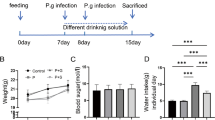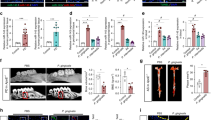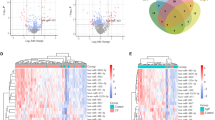Abstract
New consensus indicates type 2 diabetes mellitus (T2DM) and periodontitis as comorbidity and may share common pathways of disease progression. Sulfonylureas have been reported to improve the periodontal status in periodontitis patients. Glipizide, a sulfonylurea widely used in the treatment of T2DM, has also been reported to inhibit inflammation and angiogenesis. The effect of glipizide on the pathogenicity of periodontitis, however, has not been studied. We developed ligature-induced periodontitis in mice and treated them with different concentrations of glipizide and then analyzed the level of periodontal tissue inflammation, alveolar bone resorption, and osteoclast differentiation. Inflammatory cell infiltration and angiogenesis were analyzed using immunohistochemistry, RT-qPCR, and ELISA. Transwell assay and Western bolt analyzed macrophage migration and polarization. 16S rRNA sequencing analyzed the effect of glipizide on the oral microbial flora. mRNA sequencing of bone marrow-derived macrophages (BMMs) stimulated by P. gingivalis lipopolysaccharide (Pg-LPS) after treatment with glipizide was analyzed. Glipizide decreases alveolar bone resorption, periodontal tissue degradation, and the number of osteoclasts in periodontal tissue affected by periodontitis (PAPT). Glipizide-treated periodontitis mice showed reduced micro-vessel density and leukocyte/macrophage infiltration in PAPT. Glipizide significantly inhibited osteoclast differentiation in vitro experiments. Glipizide treatment did not affect the oral microbiome of periodontitis mice. mRNA sequencing and KEGG analysis showed that glipizide activated PI3K/AKT signaling in LPS-stimulated BMMs. Glipizide inhibited the LPS-induced migration of BMMs but promoted M2/M1 macrophage ratio in LPS-induced BMMs via activation of PI3K/AKT signaling. In conclusion, glipizide inhibits angiogenesis, macrophage inflammatory phenotype, and osteoclastogenesis to alleviate periodontitis pathogenicity suggesting its’ possible application in the treatment of periodontitis and diabetes comorbidity.






Similar content being viewed by others
Data Availability
The datasets generated and/or analyzed during the current study are available from the corresponding authors on reasonable request.
References
Yang, L., et al. 2021. Sulfonylureas for treatment of periodontitis-diabetes comorbidity-related complications: Killing two birds with one stone. Frontiers in Pharmacology 12: 728458.
Gasner, N.S. and R.S. Schure. 2022. Periodontal disease, in StatPearls. 2022, StatPearls Publishing Copyright ©, StatPearls Publishing LLC.: Treasure Island (FL).
Wang, L., et al. 2020. SLIT2 overexpression in periodontitis intensifies inflammation and alveolar bone loss, possibly via the activation of MAPK pathway. Frontiers in Cell and Development Biology 8: 593.
Bui, F.Q., et al. 2019. Association between periodontal pathogens and systemic disease. Biomedical Journal 42 (1): 27–35.
Hajishengallis, G. 2020. New developments in neutrophil biology and periodontitis. Periodontology 2000 82 (1): 78–92.
Löe, H. 1993. Periodontal disease. The sixth complication of diabetes mellitus. Diabetes Care 16 (1): 329–34.
Graves, D.T., Z. Ding, and Y. Yang. 2000. The impact of diabetes on periodontal diseases. Periodontology 2000 82 (1): 214–224.
Shi, B., et al. 2020. The subgingival microbiome associated with periodontitis in type 2 diabetes mellitus. ISME Journal 14 (2): 519–530.
Teles, R., and C.Y. Wang. 2011. Mechanisms involved in the association between periodontal diseases and cardiovascular disease. Oral Diseases 17 (5): 450–461.
Mammen, M.J., F.A. Scannapieco, and S. Sethi. 2020. Oral-lung microbiome interactions in lung diseases. Periodontology 2000 83 (1): 234–241.
Lalla, E., and P.N. Papapanou. 2011. Diabetes mellitus and periodontitis: A tale of two common interrelated diseases. Nature Reviews. Endocrinology. 7 (12): 738–748.
Lv, W., et al. 2020. Mechanisms and characteristics of sulfonylureas and glinides. Current Topics in Medicinal Chemistry 20 (1): 37–56.
Fernandez, C.J., A.V. Raveendran, and N. Htwe. 2021. Efficacy and cardiovascular safety of sulfonylureas. Current Drug Safety 16 (2): 142–153.
Araújo, A.A., et al. 2019. Gliclazide reduced oxidative stress, inflammation, and bone loss in an experimental periodontal disease model. Journal of Applied Oral Science 27: e20180211.
Kawahara, Y., et al. 2020. Effects of sulfonylureas on periodontopathic bacteria-induced inflammation. Journal of Dental Research 99 (7): 830–838.
Correa, R., B.S. Quintanilla Rodriguez, and T.M. Nappe. 2022. Glipizide in StatPearls. StatPearls Publishing. Copyright © 2022, StatPearls Publishing LLC.: Treasure Island (FL). Copyright © 2022, StatPearls Publishing LLC.: Treasure Island (FL).
Qi, C., et al. 2014. Glipizide, an antidiabetic drug, suppresses tumor growth and metastasis by inhibiting angiogenesis. Oncotarget 5 (20): 9966–9979.
Moreau, R., et al. 1997. Pharmacological and biochemical evidence for the regulation of osteocalcin secretion by potassium channels in human osteoblast-like MG-63 cells. Journal of Bone and Mineral Research 12 (12): 1984–1992.
Joya-Galeana, J., et al. 2011. Effects of insulin and oral anti-diabetic agents on glucose metabolism, vascular dysfunction and skeletal muscle inflammation in type 2 diabetic subjects. Diabetes/Metabolism Research and Reviews 27 (4): 373–382.
Sima, C., A. Viniegra, and M. Glogauer. 2019. Macrophage immunomodulation in chronic osteolytic diseases-the case of periodontitis. Journal of Leukocyte Biology 105 (3): 473–487.
Kubatzky, K.F., F. Uhle, and T. Eigenbrod. 2018. From macrophage to osteoclast - how metabolism determines function and activity. Cytokine 112: 102–115.
Pereira, M., et al.2018. Common signalling pathways in macrophage and osteoclast multinucleation. Journal of Cell Science 131 (11).
Yunna, C., et al. 2020. Macrophage M1/M2 polarization. European Journal of Pharmacology 877: 173090.
Pathak, J.L., et al. 2021. Downregulation of macrophage-specific Act-1 intensifies periodontitis and alveolar bone loss possibly via TNF/NF-κB signaling. Frontiers in Cell Development Biology 9:628139.
Zhuang, Z., et al. 2019. Induction of M2 macrophages prevents bone loss in murine periodontitis models. Journal of Dental Research 98 (2): 200–208.
Li, C., M. Levin, and D.L. Kaplan. 2016. Bioelectric modulation of macrophage polarization. Science and Reports 6: 21044.
Lin, Y.W., et al. 2018. Glyburide and retinoic acid synergize to promote wound healing by anti-inflammation and RIP140 degradation. Science and Reports 8 (1): 834.
Kewcharoenwong, C., et al. 2018. Glibenclamide reduces primary human monocyte functions against tuberculosis infection by enhancing M2 polarization. Frontiers in Immunology 9: 2109.
Abe, T., and G. Hajishengallis. 2013. Optimization of the ligature-induced periodontitis model in mice. Journal of Immunological Methods 394 (1–2): 49–54.
Wang, L., et al. 2022. SAP deficiency aggravates periodontitis possibly via C5a-C5aR signaling-mediated defective macrophage phagocytosis of Porphyromonas gingivalis. Journal of Advanced Research.
Hu, L., et al. 2022. MiR-1224-5p modulates osteogenesis by coordinating osteoblast/osteoclast differentiation via the Rap1 signaling target ADCY2. Experimental & Molecular Medicine 54 (7): 961–972.
Xiao, E., et al. 2017. Diabetes enhances IL-17 expression and alters the oral microbiome to increase its pathogenicity. Cell Host & Microbe 22 (1): 120-128.e4.
Spiller, K.L., et al. 2016. Differential gene expression in human, murine, and cell line-derived macrophages upon polarization. Experimental Cell Research 347 (1): 1–13.
Zhao, B. 2020. Intrinsic restriction of TNF-mediated inflammatory osteoclastogenesis and bone resorption. Front Endocrinol (Lausanne) 11: 583561.
Sheethal, H.S., et al. 2018. Role of mast cells in inflammatory and reactive pathologies of pulp, periapical area and periodontium. J Oral Maxillofac Pathol 22 (1): 92–97.
Yan, X., et al. 2020. Uncoupling protein-2 regulates M1 macrophage infiltration of gingiva with periodontitis. Cent Eur J Immunol 45 (1): 9–21.
Li, J., et al. 2021. 2D MOF periodontitis photodynamic ion therapy. Journal of the American Chemical Society 143 (37): 15427–15439.
Curtis, M.A., P.I. Diaz, and T.E. Van Dyke. 2020. The role of the microbiota in periodontal disease. Periodontology 2000 83 (1): 14–25.
Gu, Y., et al. 2017. Analyses of gut microbiota and plasma bile acids enable stratification of patients for antidiabetic treatment. Nature Communications 8 (1): 1785.
Ma, P., et al. 2010. Glimepiride induces proliferation and differentiation of rat osteoblasts via the PI3-kinase/Akt pathway. Metabolism 59 (3): 359–366.
Ma, P., et al. 2014. Glimepiride promotes osteogenic differentiation in rat osteoblasts via the PI3K/Akt/eNOS pathway in a high glucose microenvironment. PLoS ONE 9 (11): e112243.
Park, S.Y., et al. 2011. Schisandra chinensis α-iso-cubebenol induces heme oxygenase-1 expression through PI3K/Akt and Nrf2 signaling and has anti-inflammatory activity in Porphyromonas gingivalis lipopolysaccharide-stimulated macrophages. International Immunopharmacology 11 (11): 1907–1915.
Ying, Y., and J. Luo. 2018. Salidroside promotes human periodontal ligament cell proliferation and osteocalcin secretion via ERK1/2 and PI3K/Akt signaling pathways. Experimental and Therapeutic Medicine 15 (6): 5041–5045.
Almubarak, A., et al. 2020. Disruption of monocyte and macrophage homeostasis in periodontitis. Frontiers in Immunology 11: 330.
Sun, X., et al. 2021. Polarized macrophages in periodontitis: Characteristics, function, and molecular signaling. Frontiers in Immunology 12: 763334.
Yuan, H., et al. 2017. Osteoclast stimulatory transmembrane protein induces a phenotypic switch in macrophage polarization suppressing an M1 pro-inflammatory state. Acta Biochimica et Biophysica Sinica (Shanghai) 49 (10): 935–944.
Hasegawa, T., et al. 2019. Identification of a novel arthritis-associated osteoclast precursor macrophage regulated by FoxM1. Nature Immunology 20 (12): 1631–1643.
Lebovitz, H.E. 1985. Glipizide: a second-generation sulfonylurea hypoglycemic agent. Pharmacology, pharmacokinetics and clinical use. Pharmacotherapy 5 (2): 63–77.
Qi, C., et al. 2016. Glipizide suppresses prostate cancer progression in the TRAMP model by inhibiting angiogenesis. Science and Reports 6: 27819.
Lange, M., et al. 2007. Continuously infused glipizide reverses the hyperdynamic circulation in ovine endotoxemia. Shock 27 (6): 701–706.
Sakalauskiene, J., et al. 2016. Peripheral blood leukocytes interleukin-1 beta (IL-1β) cytokine hyper-reactivity in chronic periodontitis. Medical Science Monitor 22: 4323–4329.
Shi, D., et al. 2008. Systemic inflammation markers in patients with aggressive periodontitis: A pilot study. Journal of Periodontology 79 (12): 2340–2346.
Parisi, L., et al. 2018. Macrophage polarization in chronic inflammatory diseases: Killers or builders? Journal of Immunology Research 2018: 8917804.
Vergadi, E., et al. 2017. Akt signaling pathway in macrophage activation and M1/M2 polarization. The Journal of Immunology 198 (3): 1006–1014.
Wang, Y., et al. 2021. Quercetin-loaded ceria nanocomposite potentiate dual-directional immunoregulation via macrophage polarization against periodontal inflammation. Small (Weinheim an der Bergstrasse, Germany) 17 (41): e2101505.
Liu, L., et al. 2019. Sirt1 ameliorates monosodium urate crystal-induced inflammation by altering macrophage polarization via the PI3K/Akt/STAT6 pathway. Rheumatology (Oxford) 58 (9): 1674–1683.
Hajishengallis, G. 2015. Periodontitis: From microbial immune subversion to systemic inflammation. Nature Reviews Immunology 15 (1): 30–44.
Garrido-Mesa, N., A. Zarzuelo, and J. Gálvez. 2013. Minocycline: Far beyond an antibiotic. British Journal of Pharmacology 169 (2): 337–352.
Funding
This study was supported by the National Natural Science Foundation of China (82150410451), the Basic and Applied Basic Research Foundation of Guangdong Province (2021A1515110988), the Project of Guangzhou Science and Technology Bureau (202002030301), Guangzhou City Clinical Key Specialty Cultivation Project (2021115257), and High-Level University Construction Funding of Guangzhou Medical University (02–410-B205001293, B195002003017, 02–412-B205002-1003017, and 06–410-2106035).
Author information
Authors and Affiliations
Contributions
Xueqi Guo: conceptualization, data curation, and writing, original draft. Zhijun Huang: conceptualization, data curation, and writing, original draft. Qing Ge: conceptualization, data curation, and writing, original draft. Luxi Yang: investigation, methodology, formal analysis, and software interpreted data. Dongliang Liang: investigation, methodology, formal analysis, and software interpreted data. Yinyin Huang: investigation, methodology, formal analysis, and software interpreted data. Yiqin Jiang: investigation, methodology, formal analysis, and software interpreted data. Janak Lal Pathak: formal analysis, supervision, and writing, review and editing. Lijing Wang: formal analysis, supervision, and writing, review and editing. Linhu Ge: conceptualization, funding acquisition, supervision, validation, and writing, review and editing.
Corresponding author
Ethics declarations
Competing Interests
The authors declare no competing interests.
Additional information
Publisher's Note
Springer Nature remains neutral with regard to jurisdictional claims in published maps and institutional affiliations.
Supplementary Information
Below is the link to the electronic supplementary material.
Rights and permissions
Springer Nature or its licensor (e.g. a society or other partner) holds exclusive rights to this article under a publishing agreement with the author(s) or other rightsholder(s); author self-archiving of the accepted manuscript version of this article is solely governed by the terms of such publishing agreement and applicable law.
About this article
Cite this article
Guo, X., Huang, Z., Ge, Q. et al. Glipizide Alleviates Periodontitis Pathogenicity via Inhibition of Angiogenesis, Osteoclastogenesis and M1/M2 Macrophage Ratio in Periodontal Tissue. Inflammation 46, 1917–1931 (2023). https://doi.org/10.1007/s10753-023-01850-1
Received:
Revised:
Accepted:
Published:
Issue Date:
DOI: https://doi.org/10.1007/s10753-023-01850-1




